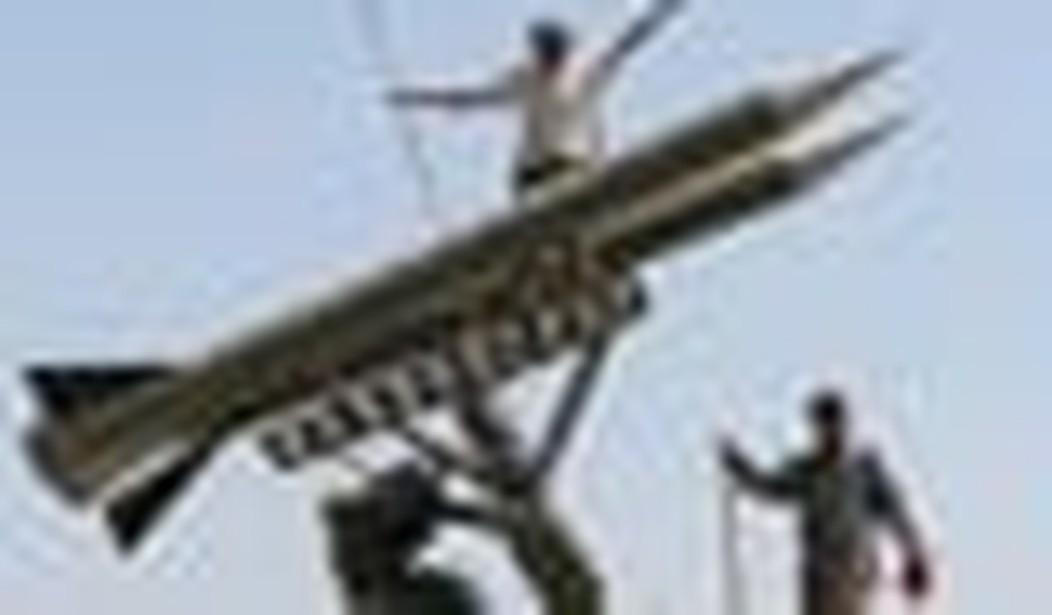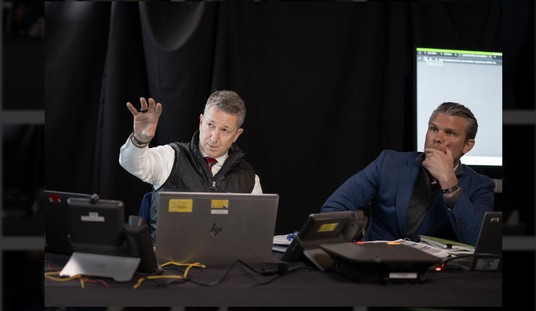In an unprecedented move, the Israeli Defense Forces have released sensitive intelligence information about the situation in southern Lebanon (available at the IDF blog). Hezbollah forces have taken over more than a hundred villages to store their heavy artillery, and their command posts are near schools and hospitals.
This represents a major shift in strategy for Hezbollah since 2006, when they stored most of their weaponry away from habitations, as befits any army that claims to want to protect its own people. But the IDF hit most of their supply in the first days of hostilities.
Hezbollah improvised by hiding behind civilians in order to shield themselves from attack while they fired at civilian targets in Israel. In a notorious incident, when an Israeli missile hit the foundation of a building near Qana in early 2006, Israeli spokeswoman Miri Eisen apologized profusely for the incident — which the media turned into a ghoulish production — assuring the world that if Israel had known that there were children in the building, they never would have fired at it.
The unintended results of this open and overriding concern for the safety of Lebanese civilians, combined with the almost addictive need on the part of Hezbollah to target Israel at any cost, has produced the current situation in which Hezbollah has essentially taken the civilians of southern Lebanon hostage. Behind the shield of these civilians, any of whose deaths the media will lay at the feet of Israel, this fanatic Shia militia has assembled an army of some 20,000 soldiers and some 40,000 short-, medium-, and long-range missiles, some hundred of which can hit Tel Aviv. In the case of renewed hostilities, these encampments would be capable of sending over 700 rockets a day into Israel.
In this context, it’s worth remembering the Francop, the ship laden with arms from Iran sent to Hezbollah and intercepted by the IDF. There were roughly 10,000 rockets found on the Francop, two and half times the number of rockets fired at Israel during the 2006 summer war.
We gain glimpses of the costs of this process over the last four years. In August of the same year, villagers attacked some Hezbollah operatives and tried to kick them out of the village. Their concerns were confirmed in the village of Tayr Filsay in October 2009, when one of the weapons store houses blew up. Hezbollah cordoned off the area to remove the rest of the weapons before they would let the Lebanese army or UNIFIL in to inspect.
The Israeli authorities chose to reveal this information even at the risk of some undesired disclosures about their intelligence capacities. (No army wants to let the other know what they know about them.) This move clearly took aim at both the UNIFIL troops — whose new commander Major General Alberto Asarta Cuevas received a copy — and UN authorities in New York, where a delegation arrived this week with the evidence. The move coincided with Prime Minister Benjamin Netanyahu’s visit with UN Secretary General Ban Ki-moon. Ki-moon’s recent comments on the tensions in Lebanon placed the blame on Israel for complaining about Hezbollah’s behavior but did not criticize Hezbollah’s illegal arms build-up itself — a classic expression of appeasement syndrome.
In a larger sense, Israel may have taken the risk to be proactive this time, after a decade of being accused of wantonly killing innocent civilians despite their unprecedented efforts to avoid doing so. These cannibalistic strategies of Hezbollah are very similar to those Hamas developed during the 2008-2009 Operation Cast Lead. Both strategies seek to maximize their own civilian casualties for the value of those deaths in demonizing Israel as killers of innocent civilians. Israel apparently hopes to dampen some of the outrage — which arises so readily from the media and diplomatic services — by pointing out this cannibalistic strategy that so cruelly sacrifices its own people in the service of its goals.
Perhaps the most tragic dimension of this strategy comes from the key role the mainstream media plays in this process. As one Gazan explained to an Italian journalist during Operation Cast Lead:
The Hamas militants looked for good places to provoke the Israelis. They were usually youths, 16 or 17 years old, armed with submachine guns. They couldn’t do anything against a tank or jet. They knew they were much weaker. But they wanted the [Israelis] to shoot at the [the civilians’] houses so they could accuse them of more war crimes [emphasis added].
So this cruel racket of sacrificing civilians only works if the Israelis are blamed, only if the MSM provides the stage on which this death cult can accuse Israel of “more war crimes.” If the media — and the “Human Rights” NGOs and UN Human Rights Council initiatives like the Goldstone Report — highlighted these pre-meditated war crimes of Hamas and Hezbollah, then the ploy wouldn’t work. In a profound sense, it is only because the media plays the game the way these terrorist organizations dictate it that it even makes sense to maximize one’s own side’s suffering.
So let’s see what happens. Does the MSM recognize its unconscionable role in this unnecessary tragedy? Will they inform the world of these intentional war crimes against the Lebanese people? Or will they ignore this “non-story,” and then when the rockets fly and civilians die again, will they — also again — join in the chorus of accusing Israel of reckless criminal behavior? I’m personally not betting on maturity.









Join the conversation as a VIP Member